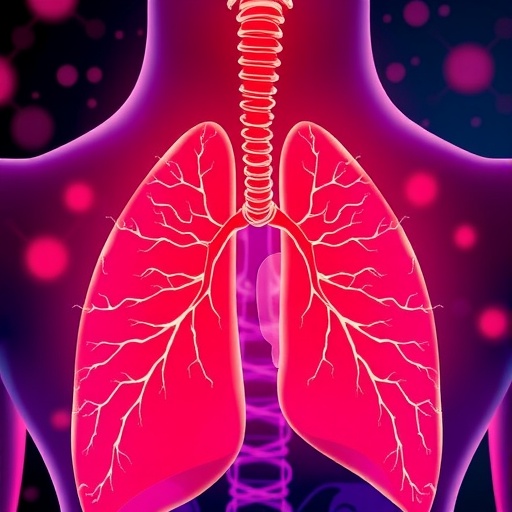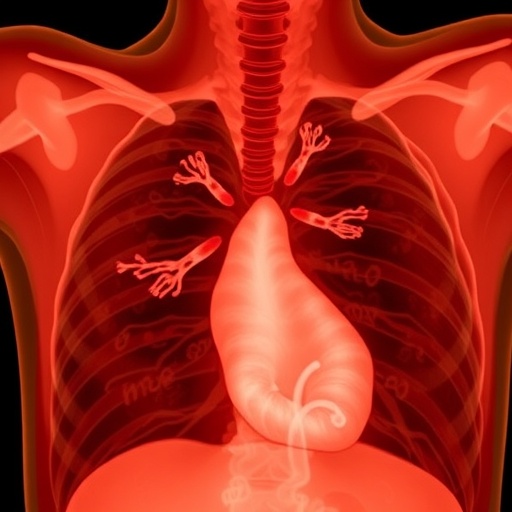Credit: Zunlong Ke and Elizabeth Wright at Emory/Georgia Tech
Researchers have been able to capture images of measles viruses as they emerge from infected cells, using state of the art cryo-electron tomography techniques. The new images will help with a greater understanding of measles and related viruses, and could give hints on antiviral drug strategies likely to work across multiple viruses of this type.
The results were published Monday, April 30 in Nature Communications.
Scientists led by Elizabeth Wright, PhD, and Zunlong Ke, PhD, say they can discern an internal matrix protein acting as a scaffold, with the encapsidated genetic material visible as "snakes" close to the viral membrane.
An effective vaccine is available against measles virus, a highly infectious viral pathogen. Yet there is still a lot about the virus scientists don't understand, Ke says. In addition, understanding the internal organization of measles virus could guide the study of related viruses, such as parainfluenza and respiratory syncytial virus (RSV), common causes of respiratory illnesses, and Nipah virus, an inspiration for the film Contagion.
Wright is associate professor of pediatrics at Emory University School of Medicine and Children's Healthcare of Atlanta, director of the Robert P. Apkarian Integrated Electron Microscopy Core, and a Georgia Research Alliance Distinguished Investigator. Ke is a former Georgia Tech graduate student who is starting a postdoctoral position this summer at the MRC Laboratory of Molecular Biology in Cambridge, UK. Ke and Emory staff scientist Joshua Strauss, PhD are co-first authors of the paper.
Wright, Ke, and colleagues decided to examine virus-infected cells directly a couple years ago, after working with purified viruses for a long time. The team collaborated with Richard Plemper, PhD, who specializes in measles virus and is now at Georgia State University. The family of viruses that includes measles, paramyxoviruses, are difficult to work with, because of their low titers, instability and heterogeneity, Wright says.
For structural studies, researchers usually concentrate and purify viruses by centrifuging them through thick solutions. But this is tricky for measles virus and other enveloped viruses such as RSV. Ke likens purified virus to a bucket of water balloons of different sizes, which are squishy and prone to burst, frustrating efforts to visualize them.
"Instead, we grow and infect the cells directly on the grids we use for microscopy, and rapidly freeze them, right at the stage when they are forming new viruses," Ke says.
Improvements in technology, such as direct electron detectors and software that corrects for beam-induced motion in the frozen sample, make it possible to achieve higher resolution cryo-EM structures. Cryo-electron tomography (cryo-ET), ideal for studying viruses that come in different shapes and sizes, uses an electron microscope to obtain a series of 2D pictures of the viruses as the sample holder is tilted to multiple angles along one axis. The images and the angular information are then used to compute the 3D volume of the virus, much like a medical CT scan, Wright says.
"We would never see this level of detail with purified virus, because the process of purification disrupts and damages the delicate virus particles," she says. "With the whole-cell tomography approach, we can collect data on hundreds of viruses during stages of assembly and when released. This allows us to capture the full spectrum of structures along the virus assembly pathway."
For example, the scientists can now see the organization of glycoproteins on the surface of the viral membrane. Previous work showed two glycoproteins were present on the membrane, but they were a "forest of trees," where there was insufficient detail to identify each one.
In this study, the team was able to resolve the two glycoproteins and determine that one of them, the fusion (F) protein, was organized into a well-defined lattice supported by interactions with the matrix protein. In addition, they can see "paracrystalline arrays" of the matrix protein, called M, under the membrane. The arrays had not been seen in measles virus-infected cells or individual measles virus particles before, Wright says. Under the microscope, these arrays look a bit like Lego grid plates, from which the rest of the virus is built and ordered.
The new 3D structures also argue against a previous model of viral assembly, which had the RNP (ribonucleoprotein) genetic material as a core, and the M protein forming a coat around it.
The scientists are still figuring out what makes measles virus have a bulbous shape while RSV is more filamentous. Ke thinks the scaffold role of M is similar for related viruses, although as the virus assembles, the individual structural proteins may coordinate uniquely to produce virus particles with different shapes that better support their replication cycle.
###
This work was supported in part by Emory University; Children's Healthcare of Atlanta; the Georgia Research Alliance; the Center for AIDS Research at Emory University (P30 AI050409); the James B. Pendleton Charitable Trust; public health service grants R01AI083402 and R01HD079327, R01GM114561, R21AI101775, and F32GM112517; and NSF grant 0923395.
Media Contact
Quinn Eastman
[email protected]
404-727-7829
@emoryhealthsci
http://whsc.emory.edu/home/news/index.html
Original Source
http://news.emory.edu/stories/2018/05/wright_measles_nc/index.html http://dx.doi.org/10.1038/s41467-018-04058-2




